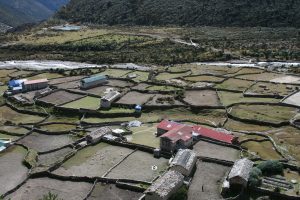Development Series- Part IV: Advancing Human Development in Kerala, India
Summary from Just and Lasting Change by Associate Professor, Noam Schimmel

Human development that significantly advances quality of life does not have to be expensive.
It is often assumed that to make major advances in the quality of human well-being development efforts that address healthcare, education, food security, and the well-being of women and children are necessarily extremely resource intensive and therefore dependent on massive outlays of funding to advance human security.
But this is not the case.
Successful forms of development that have been transformative in positive ways and are well documented in development literature show that human well-being can be advanced with basic resources that can be found in most communities, including in countries that lack financial resources and are classified as low income.
Put simply, financial wealth is not a prerequisite for fundamental human development.

More significantly, trust, cooperative communal efforts to pool resources and expand them, careful and equitable planning, and support of local and national government coupled with local grassroots efforts are often sufficient to advance human development.
These advances lead to tangible improvements in life expectancy, improve quality of life and enhance health outcomes, promote the realization of the human rights of children and women and human rights more broadly, expand educational opportunities, and raise incomes and improve food security.
How is this possible and where has this been done? In Kerala, India.
Kerala, a region of South India, made huge advancements in human development without being dependent on external aid for enabling this transformation.
Kerala achieved the best health and education levels of development in India already by the 1960s, and continues to sustain them, while also maintaining the highest rate of political participation in India.

But, counterintuitively, it was also the poorest state in India when it had these dramatic health and education achievements.
In this seeming contradiction we can find vitally important lessons about advancing human development which may be counterintuitive, and for that reason merit attention.
Development research attributes Kerala’s outstanding social achievements to several factors.
Daniel and Carl Taylor, pioneers of community development together with UNICEF, explain that these include political leadership that was largely genuinely interested in advancing the welfare of Kerala’s residents and was not morally corrupt, a matrilineal tradition amongst many high caste Hindus in Kerala, a church that grew in adherents and advanced greater equity amongst its values and aspirations and promoted interreligious tolerance that also received the support of Hindus, and a progressive people’s movement that advanced social reforms.
According to Taylor and Taylor, this social movement initially fought back against caste-based discrimination but continued beyond that, advancing public literacy and education, promoting land reform, and making scientific knowledge broadly available to the public which has also played a role in public advocacy for continued environmental conservation.
Momentum built on momentum in positive interlocking ways: advancing women’s rights, promoting expanded educational opportunity, and providing enhance economic opportunities for trade that were open to a broad cross-section of the population all acted synergistically to advance human development.

The high literacy rate, for example, has enabled the average Keralan to follow newspapers and hold political leadership accountable in democratic elections and in between elections.
The evidence Taylor and Taylor provide is substantive and significant: In 2001 while life expectancy was 74 years in Kerala it was 59 years in all of India. Literacy in Kerala amongst females was 87%, while it was only 39% in all of India. In 2011, Kerala was the only state in India in which there was no preference for male babies; in 1991 its gender ratio was 1,036 females to 1,000 males, compared with 927 females to 1,000 males for India as a whole.
Kerala’s successes are impressive, sustained, and genuinely life altering for individuals and for society.
Taylor and Taylor note that economic wealth did eventually result from these substantial advances in human development in Kerala.
Today Kerala enjoys both high levels of social development and economic growth and greatly increased financial resources.
It is instructive to turn to Kerala’s history to learn that opportunities abound even in places that are initially resource-poor.
Human development can be enabled and derive energy from largely indigenous sources.
To be sure, Kerala’s model is unique to Kerala and its circumstances.

But undoubtedly, it has lessons for all countries seeking to advance human development and to the United States and other countries when conceptualizing and implementing development aid.
These lessons are encouraging in their affirmation of local capacity to advance positive social change from within that draws upon domestic human resources, some – but relatively moderate support from abroad, and the values and social policies that advance equity, social justice, and human emancipation which ultimately can unleash human development and well-being.
Development Series- Part III: SEED-SCALE in Nepal
Adapted from Empowerment on an Unstable Planet: From Seeds of Human Energy to a Scale of Global Change, by Daniel Taylor, Carl E. Taylor, and Jesse O. Taylor

(All photos throughout post taken from various Future Generations activities in Nepal.)
Traditional development has not dealt kindly with Nepal and has not succeeded despite huge investments of both human and financial resources over many decades.
If the best current development practices were effective, then they should have worked in Nepal. Six decades, several billion dollars, and the careers of some of the world’s finest development professionals were invested in the kingdom to reduce poverty, illiteracy, and illness. Yet today, 30 percent of Nepal’s population remains below the poverty line, with one-fifth of the country living on less than a dollar a day; half the population is illiterate, and mortality for children under age five is sixty per thousand live births.
How is this possible and what were its causes?
There were plenty of good intentions in all the right places. Economic growth was to reduce poverty. Education and elections were to build accountable government. Health services were to double life expectancy. For each, targets were set, and programs were generously funded. But while there was progress in many measurable program indicators, in each sector dysfunction grew in terms of how system relationships were functioning. Programs that were started fell apart when funding was diverted to other programs that interested donors. Newly built school buildings and schools a few years after being built by donors looked abandoned.

This dynamic is not unique to Nepal. Indeed, it characterizes the failures of traditional development programs around the world which Nepali development projects typified.
Intentions were good, outcomes were not.
Looking at Nepal as a case study helps to understand why community-based development that is genuinely communally oriented and involves real local participation and implementation is far more likely to succeed and be sustainable than traditional development projects reflecting huge, external outlays of cash and foreign expertise, but without local participation.
Without an integrated role for the Nepali government on national and regional levels to work in a three-way partnership both with local Nepali communities and with external development and aid agencies – and the resources and expertise they bring – development in Nepal was not sustainable.
The Taylors argue that although Nepal lacked financial and human resources initially, in the 1950s, when development projects began, Nepal actually had access to extensive financial and human resources available since that time, for over sixty years. In other words, the failure of Nepal’s development trajectory is not because development was working and was simply underfunded and/or not sufficiently expanded across the country. The problem was and remains that it was not working effectively, and it was not responsive to community needs.

According to the Taylors, by 1999 the bottom fifth of Nepal’s population suffered from greater poverty, malnutrition, and lower overall human development than in 1949. Traditional development programs implemented during these fifty years did not consider how the Nepali economy in the 1950s and through the 1990s was systematically excluding a huge sector of the Nepali population.
The core reason why the quality of life had gone down for the bottom quintile was that the currency of change had shifted. In 1949, a barter economy based on human energies gave employment options to poor people; but by 1999 the monetary economy had removed labor-based options; money was now required to participate in the modern world.
Had traditional development efforts been sensitive and responsive to this reality and the challenges it created for one fifth of the population, Nepal’s development trajectory would likely have been a much different and better one.
But they were not.
Further, even the development efforts they pursued that reached some of the remaining 80% of Nepal’s population, had relatively poor results and often ended in neglect or desertion because they did not link local communities in a meaningful, participatory way with the regional and national government and with foreign aid agencies and were not communal oriented.
Pockets of development would often take place in an isolated, temporally-bound manner creating the illusion of development momentum and positive change. Once the money and human resources stopped coming in, the development projects ended, development indicators declined, and local communities had neither gained in capacities nor resources to advance their own development and sustain it.
By definition, a program of development that relies primarily on external support and that does not reflect local communal needs and participation will eventually peeter out when funding ends and when human resources experts complete whatever block of time they have committed to a particular development project and country. When they leave and when funding ends, projects decline and eventually – often – die out altogether, with no one locally available to maintain and continue them.
Thus, there were decades when it appeared that traditional development was working: roads were being built, schools constructed and staffed with teachers, the economy diversifying, and Nepalis working abroad and returning to Nepal remittances that assisted Nepalis in Nepal to raise their incomes and their human development. Hotels and restaurants opened in Katmandu raising incomes and increasing employment there.

But these economic changes and expansions were not well distributed across the country in an equitable way and many were not long lasting.
The lack of democratic accountability, a rigid and exclusionary caste system, and high levels of corruption all contributed to the failure to advance development that was genuinely and sustainably transformative.
The international community acquiesced in maintaining old-order structures. For example, during these decades not one embassy or aid agency had more than a handful of token low-caste employees in managerial positions or engaged in systematic affirmative action hiring. Development was growing into a world of appearances: outputs were measured and contracts fulfilled, but connections between programs tended to be ignored.
When the monarchy was overthrown what resulted was civil war, mass violence, and chaos. Although efforts were made to write a new constitution and find more effective forms of governance that were truly inclusive and responded to the needs of the people, corruption, dysfunction, inequality, injustice, lack of responsiveness to local and regional needs and preferences, and collapse of the rule of law characterized Nepal.

By 2010, a once-expanding infrastructure built by foreign assistance was crumbling: roads, government offices, clinics, schools, postal services, agriculture extension services, even tax collection. An increasingly corrupt government system could not maintain infrastructure that aid had built. Ancient divisions of caste and tribe persisted, crippling social advancement as half of the national population, women, still were only symbolically included in decision making.
In contrast to the failures of traditional development efforts, Nepal has had substantial success in local, community-based development efforts – though these have not been extensive enough to lift the entire country out of poverty and they have received far less support from both the Nepali government and external donors than traditional development efforts. Many of these efforts are ongoing.
Nepal is filled with such examples [of community based development]: community-based clinics and schools, forests, microcredit schemes, and water supply systems. Even more persuasive proof of people’s energies are the thousands of trails, temples, village waterspouts, and herculean terraces built without any external assistance… Another example of the diffuse, emergent manner in which the people pulled themselves forward lies in Nepal’s ecotourism industry.

But these successes, outside of several select cases such as eco-tourism, have not been able to scale-up and are limited to local, grassroots initiatives.
Nepal is perhaps unusual in that although it has a record of failed traditional development – as many countries do – it simultaneously has a record of successful community based development which many countries do not.
Nepalis knows how to lift themselves out of poverty and advance their development.
SEED-SCALE has been well demonstrated in Nepal in a variety of contexts – from community-based road and bridge building efforts that have been high quality and extremely cost effective – with lasting benefit expanding trade and enabling improved travel for access to healthcare and markets to sell goods and services and produce grown in the countryside – to a sophisticated eco-tourism enterprise and range of extensive tourism related businesses incorporating tour guides, restaurants and hotels.

Many Nepalis have adapted to the opportunities provided by tourism to increase their income and use that income to improvetheir quality of life through better healthcare, housing, and educational opportunity.
While many of these programs have not been able to expand beyond largely localized programs, if the Nepali government on the national and regional level and foreign donors and aid agencies learn from the mistakes of the past and build on the successes of SEED-SCALE, Nepal will be able to advance its own development sustainably and successfully.
Then the community development that is currently taking place on a relatively small scale could eventually characterize the country as a whole for the better of all its citizens and contribute to equitable, expansive, participatory, and sustainable human development.
Development Series- Part II: Community Development from the Grassroots

This week, we’re excited to announce that Professor Schimmel’s second post in the Development Series can be found on McGill University’s Centre for Human Rights & Legal Pluralism blog! Follow the link below to read his assessment on how the SEED-SCALE theory of social change can benefit the larger field of development.
https://www.mcgill.ca/humanrights/article/community-development-grassroots
Development Series- Part I: SEED-SCALE in Cities: Curitiba, Brazil
Summary from Just and Lasting Change by Associate Professor, Noam Schimmel

Patterns of human settlement are becoming increasingly urban and with these changes come both challenges and opportunities to advance human development.
Health Series- Part IV: Community-Based Development in Ding Xian, China
Summary from Just and Lasting Change by Associate Professor, Noam Schimmel
Go to the People.
Live with the People,
Learn from the People.
Plan with the People.
Work with the People.
Start with what they know,
Build on what they have.
Teach by showing, learn by doing.
Not a showcase, but a pattern.
Not piecemeal, but integrated.
Not odds and ends, but a system.
Not to conform, but to transform.
Not relief, but release.
-Jimmy Yen (yen Yangchu)


